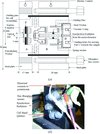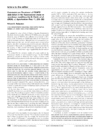issue contents
November 2004 issue

Cover illustration: Magnetic speckle pattern obtained using coherent soft X-ray resonant magnetic scattering from a FePd thin film with periodic magnetic stripe domains, see Chesnel, van der Laan, Livet, Beutier, Marty, Belakhovsky, Haznar and Collins, pages 469-475. The inset shows the enlarged image of the speckle pattern of the magnetic satellite at the left hand side.
facility information
research papers
Three near-identical protein crystallography beamlines with a single 6 T peak field superconducting dipole bend magnet as the source have been built at the 1.9 GeV Advanced Light Source. The design and performance of this new facility is described.
Fast X-ray area detectors based on the combination of a fast CCD camera with an X-ray image intensifier or with a high-resolution detector have been developed at SPring-8.
Radiation damage to a protein solution was investigated by synchrotron X-ray small-angle scattering.
An FePd thin film sample with periodic magnetic stripe domains has been measured with coherent soft x-ray resonant magnetic scattering in reflection geometry. Short exposure to a magnetic field gives a strong change in the observed intensity fluctuations in the scattered magnetic speckle pattern, which indicates a large degree of variation between the two patterns taken before and after field exposure.
The partial Talbot effect is the self-imaging of some Fourier components of the intensity distribution recorded at specific distances from a periodic object. It provides a convenient quantitative determination of the coherence of the synchrotron radiation beam in the object plane.
A general outline of how to perform a light-excited time-resolved diffraction experiment by applying the optical pump/X-ray probe technique is given.
SRCD, WAXS and SAXS measured at second-generation synchrotron storage-ring beamlines were used to investigate the structure of a complex of two proteins in solution.
A novel design of the electrochemical in situ reaction cell which can be used for different spectroscopic techniques, long-term X-ray experiments on battery electrodes materials during the lithium-extraction/insertion process, in order to determine the structural perturbations occurring in the system and charge compensation mechanism during cycling.
short communications
The first ever time-resolved SAXS data collected on the ChemMatCARS beamline are presented, to provide an indication of the current beamline capabilities.
letters to the editor
Free 

Correcting for fast-channel dead time is suggested as a means for further improving the accuracy of EXAFS data collected under non-linear conditions.
Free 

Responses are made to W. K. Warburton's comments in the previous paper concerning the treatment of EXAFS data taken in the fluorescence mode in non-linear conditions presented earlier.
current events
Free 



 journal menu
journal menu
































